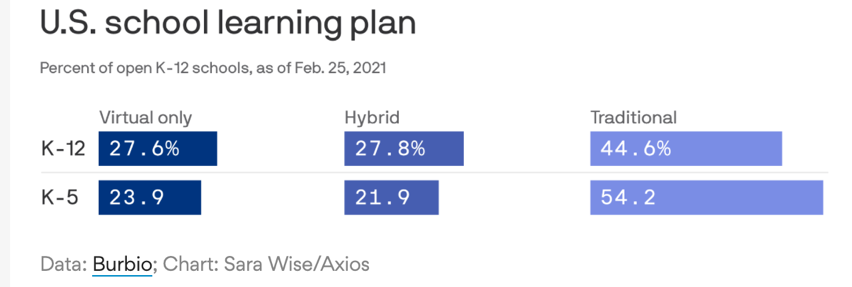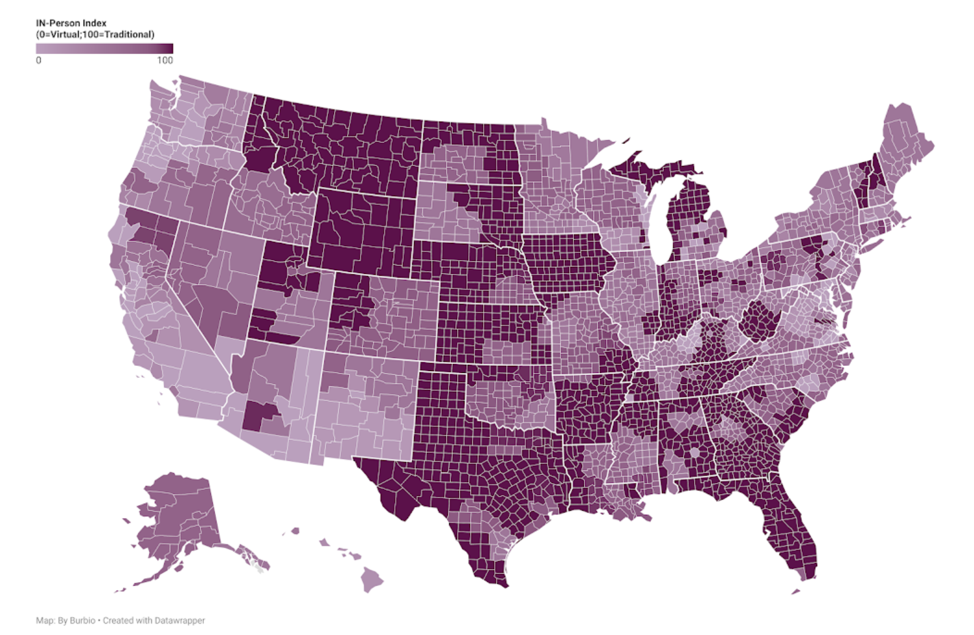 Covering COVID-19 is a daily Poynter briefing of story ideas about the coronavirus and other timely topics for journalists, written by senior faculty Al Tompkins. Sign up here to have it delivered to your inbox every weekday morning.
Covering COVID-19 is a daily Poynter briefing of story ideas about the coronavirus and other timely topics for journalists, written by senior faculty Al Tompkins. Sign up here to have it delivered to your inbox every weekday morning.
Moderna hopes to have the results from drug trials involving teenagers to be able to get Food and Drug Administration approval in time to offer COVID-19 vaccines for kids before classes start this fall.
There are trials underway right now involving thousands of teenagers. The New York Times explains:
By testing increasingly younger ages, researchers hope to determine whether side effects play out similarly in adolescents and whether the vaccine reaches the same 95 percent efficacy in kids that it does in adults. That seems likely, given “the generally healthy and robust immune response in children 12 to 16 years old,” said Dr. Jill Weatherhead, an assistant professor of infectious disease at Baylor College of Medicine in Houston.
The drug companies do not know until they try their vaccines out on humans whether they should use the same dosage as adults for young people or whether young people need more medicine or less. There are also questions about how long protection lasts for people of different ages. The Times reports:
Clinical trials typically begin with adult subjects, because they can give informed consent and serious side effects can be identified before kids are tested. Researchers also like to test vaccines on various ages separately because some aren’t safe or don’t work in younger people, said Dr. Robert Jacobson, a pediatrician and medical director of the Mayo Clinic’s Primary Care Immunization Program in Rochester, Minn. For example, the M.M.R. (measles, mumps and rubella), chickenpox and hepatitis A vaccines do not work well in those under 12 months, and the flu shot doesn’t work in babies under 6 months.
While drug trials for teens are underway, it will be even longer, perhaps into 2022, before we will have enough data to vaccinate younger children.
Parents of children who have disabilities are caught between wanting their kids to get back into classrooms and concerns that their children’s conditions will make them more susceptible to the virus. Until there is a vaccine approved for younger students, children with severe health problems may still be out of the classroom.
“Many of these children are at risk for respiratory infections or feeding difficulties or lack of oxygen with subsequent seizures,” said Dr. Sarmistha Hauger, chief of Pediatric Infectious Disease at Dell Children’s Medical Center.
Dr. Hauger explained that recent data shows that children who are medically fragile are at greater risk if they get the virus.
“Children that are medically complex — children that have other health problems — tend to get sicker, tend to end up in the ICU more, tend to need more support,” said Dr. Hauger. “But the outcome is also better than adults.”
A study of forty-six North American pediatric ICUs, showed that during late March and early April of last year, 83% of medically fragile children with the virus ended up in ICU,” according to JAMA Pediatrics, a medical journal.
March’s grand school reopening
Burbio — a site that aggregates school, government, library and community event information — is tracking about 1,200 school districts, including the 200 largest in the U.S. This week’s update shows a sharp move to reopen classrooms.
But still, most high school students are not in the classroom full time and a fourth of all K-12 students are learning virtually full time. In the coming weeks, California will begin loosening restrictions on in-person learning. Chicago reopened K-5 classes this week. Philadelphia reopens to teachers on Wednesday and will open 53 schools to in-person learning next week. Seattle schools are much slower to reopen above second grade.

(Axios/Burbio)
Should schools extend their calendars to make up for learning losses?
Denver schools will start talking this week about the notion of extending the school calendar for kids who have missed out on learning during virtual teaching. Other school systems have considered a range of options, from offering summer classes to offering a couple of weeks before the official start of school in the fall. Michigan is considering adding more days to the traditional 180-day calendar.
All of this sounds expensive, but President Joe Biden’s pending stimulus plan includes $135 billion to help K-12 schools. The plan would give governors a lot of discretion on how to spend about $5 billion of it.
Millions are not getting the second COVID-19 vaccine on time
A CBS MoneyWatch examination of Centers for Disease Control and Prevention data finds that millions of Americans are not getting their second COVID-19 vaccine within the FDA-approved timeframe.
Just over 2.8 million Americans who had received their first shot — nearly 12% of those vaccinated — had not gotten their second dose within the 28-day interval prescribed for Moderna’s vaccine, one of two approved for use in the U.S. The other vaccine, jointly produced by Pfizer and Germany’s BioNTech, is supposed to be administered 21 days after getting a first dose.
The CBS story says that some people fail to show up for the second shot, which is one reason experts are hopeful about the one-dose Johnson & Johnson vaccine the FDA just approved.
Dr. David Basel, head of vaccinations for Avera Medical in Sioux Falls, South Dakota, one of the biggest health care networks in the state, said no-shows for the second shot accounted for less than 1% of all vaccinations there. The biggest reason people don’t show up between shots is an illness in the interim, he added: “We are vaccinating the elderly and most at-risk populations first. People get sick, and it’s often not with COVID.”
More encouragingly, some health experts think that delays in second doses of vaccine do not doom the U.S. vaccination effort. Earlier this month, the CDC released new guidance that second shots could be administered as late as 42 days after the first dose, although the agency reiterated that a second jab within 21 or 28 days was optimal.
Recent early studies also suggest that a single shot still provides significant protection against spreading the coronavirus, though not as much as two shots do.
“In the grand scheme of things, when you look at the other problems we are having, this is a minor issue,” said Will Humble, a former top public health official in Arizona.
The Pfizer vaccine may not be as effective for obese people
The thing about pushing a vaccine that moves from development to distribution in less than a year is that we are still learning that it works less well for certain populations. Italian researchers are learning that the Pfizer COVID-19 vaccine seems to produce fewer antibodies in obese patients. It may mean that obese people will need a booster shot at some point. Other studies have tracked how obesity is linked to more severe cases of COVID-19 and, as a result, a significantly higher fatality rate.
Watching the March 4 conspiracy
QAnon followers are still pinning their hopes on March 4, the date when those conspiracy theorists think President Biden will be toppled as president and Donald Trump will be sworn in again. You can read more if you care. Some Qs who have been burned by nonsense many times are backing away from it. Just in case, there will still be several thousand National Guard members in Washington, D.C., through mid-month.
How the pandemic is causing used car prices to spike
There are lots of factors feeding a sharp increase in used car prices. In part, the supply of used cars is directly connected with the pandemic. In past years, rental car companies bought a lot of new cars, rented them and then sold the lightly used cars. But with fewer people traveling by rental car, rental companies have bought fewer new vehicles and the whole supply line dried up. Experts say there will be millions of fewer cars available in the U.S. over the next few years.
The average price of a used vehicle surged nearly 14% — roughly 10 times the rate of inflation — to over $23,000. It was among the fastest such increases in decades, said Ivan Drury, a senior manager of insights for Edmunds.com.
The main reason for the exploding prices is a simple one of economics: Too few vehicles available for sale during the pandemic and too many buyers. The price hikes come at a terrible time for buyers, many of whom are struggling financially or looking for vehicles to avoid public transit or ride hailing because the virus. And dealers and analysts say the elevated prices could endure or rise even further for months or years, with new vehicle inventories tight and fewer trade-ins coming onto dealers’ lots.
New car prices are rising too, just not as fast.
Spring break in a second pandemic year — in a word, ‘dismal’
The pandemic began just before spring break 2020 and now, in year two, destinations like Florida are hoping to attract more revelers but know it won’t be like old times. Steve Hayes, president of Visit St. Pete Clearwater, says lots of universities have canceled spring break and Europeans can’t come here.
Miami Beach and Fort Lauderdale noticed the crowds started picking up this weekend. Miami Beach is hoping for a 20% increase in hotel bookings over last year. But Florida towns say they will not tolerate big crowds.
Las Vegas is planning a scaled-down reopening for spring breakers.
And you may see more senior citizens on a spring break of their own. Since they have been the first to get vaccinated, travel planners say seniors will hit the road first, too.
Vanlife in a pandemic

(Shutterstock)
Volkswagen is trying to connect with a new generation of pandemic microbus lovers with a planned revival of the microbus it’s calling the ID.Buzz. Volkswagen says its microbus will be electric and autonomous (meaning it will drive itself at some level).
The whole concept is keyed to a “vanlife” movement that apparently is taking off during the pandemic in which people are traveling the country living out of vans. USA Today says:
Not everybody is able to make it work, as many Americans are struggling during the pandemic. Facing joblessness or reduced income, some have lost their homes and are living in their vehicles because they have no other options.
But for those who can afford it, #vanlife is particularly well suited for this crisis because it’s socially distanced, can be done on a budget and fosters outdoor activities, which are safer during the outbreak than indoor environments where air doesn’t circulate well.
For the automotive industry, it’s a welcome development. While old-fashioned passenger vans sold to the public have largely been discontinued, brands that sell commercial vans, including Mercedes, Ram and Ford, are celebrating the trend.
Mercedes, whose Sprinter van is the vehicle of choice for many #vanlife followers, appears to be the biggest winner. Mercedes-Benz U.S. van sales soared 22.5% in 2020, even as the brand’s overall sales fell 8.9%.
“Everybody’s trying to get their hands on a van,” says Stefanie Doemel, who manages upfit solutions for vans at Mercedes-Benz USA.
Throwing (actual) shade on Miami

The sun peeks out from the palm trees on Tuesday, June 4, 2019, in Miami. (AP Photo/Brynn Anderson)
Miami captured a lot of attention recently when the city said it would increase the number of shade-providing trees. Right now, about 55% of the city’s almost 49,000 trees are palm trees. The city says it wants to do more to limit warming and improve air quality and will plant 1,300 shade trees in the coming years.
It makes me wonder what other cities are doing these days to enforce arbor laws.
We’ll be back tomorrow with a new edition of Covering COVID-19. Sign up here to get it delivered right to your inbox.









